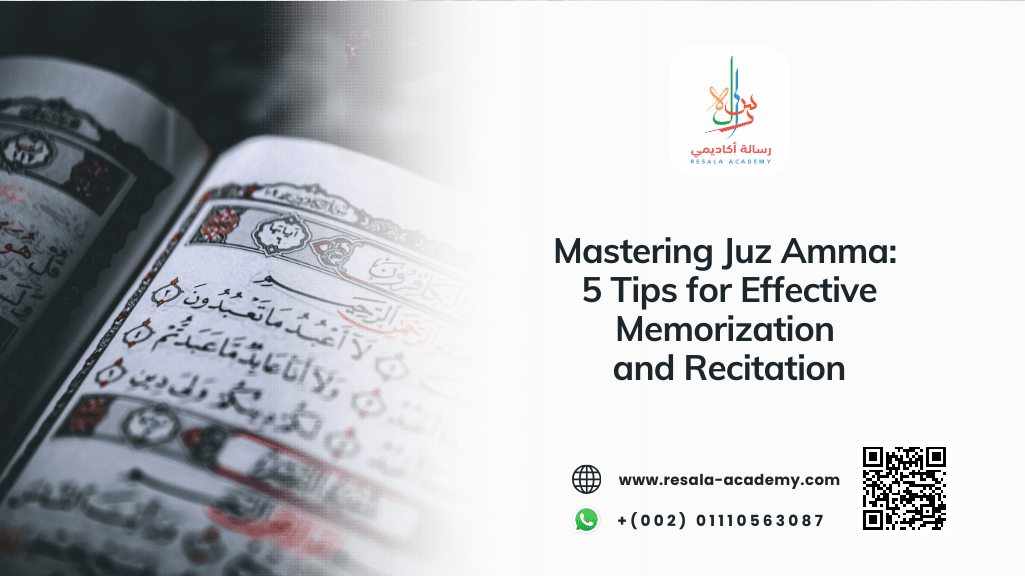Table of Contents
Tanween in Quran Recitation: How to Identify and Apply It Correctly
The Quran is a miraculous text, revered for its linguistic perfection and divine guidance. For students of Quranic recitation, understanding the rules of Tajweed (the art of Quranic pronunciation) is essential to articulate its verses properly.
One of the fundamental aspects of Tajweed is Tanween. This article will explore what Tanween is, how to identify it, and how to apply it correctly in Quran recitation. Additionally, we will highlight how Resala Academy can help non-native speakers master the Quran and Arabic language.
What Is Tanween?
Tanween refers to doubling a short vowel sound at the end of a noun or adjective in Arabic. It is represented by two diacritical marks (ً, ٍ, ٌ) and is pronounced as an “n” sound.
Tanween is a linguistic feature of Arabic that serves grammatical and phonetic purposes, such as indicating indefiniteness or adding rhythm to speech.
In the Quran, Tanween plays a crucial role in proper recitation. Mispronouncing Tanween can alter the meaning of a word, which is why mastering this concept is vital for anyone learning Quranic Arabic.
Types of Tanween
There are three types of Tanween in Arabic, each with its unique pronunciation and function:
1. Tanween Al-Fath (ً):
- Represented by two Fatha marks (ــًــ).
- Pronounced as “an” at the end of a word.
- Example: كِتَابًا (Kitāban – a book).
2. Tanween Al-Kasr (ٍ):
- Represented by two Kasra marks (ــٍــ).
- Pronounced as “in” at the end of a word.
- Example: كِتَابٍ (Kitābin – of a book).
3. Tanween Al-Damm (ٌ):
- Represented by two Damma marks (ــٌــ).
- Pronounced as “un” at the end of a word.
- Example: كِتَابٌ (Kitābun – a book).
Each type of Tanween has specific rules for pronunciation, especially when followed by certain letters. These rules are governed by Online Tajweed Course, which ensure the Quran is recited as it was revealed.
The Role of Tanween in Quran Recitation
In Quranic recitation, Tanween is not merely a grammatical feature—it is a phonetic tool that enhances the beauty and rhythm of the Quran. Proper application of Tanween ensures that the recitation flows smoothly and adheres to the rules of Tajweed.
Examples of Tanween in the Quran
ذَٰلِكَ ٱلۡكِتَٰبُ لَا رَيۡبَۛ فِيهِۛ هُدٗى لِّلۡمُتَّقِينَ
“This is the Book about which there is no doubt, a guidance for those conscious of Allah.”
– The word هُدًى (Hudan) contains Tanween Al-Fath.
وَلَمۡ يَكُن لَّهُۥ كُفُوٗا أَحَدُۢ
“And there is none comparable to Him.”
– The word كُفُوًا (Kufuwan) contains Tanween Al-Fath.
تَنَزَّلُ ٱلۡمَلَـٰٓئِكَةُ وَٱلرُّوحُ فِيهَا بِإِذۡنِ رَبِّهِم مِّن كُلِّ أَمۡرٍ
“The angels and the Spirit descend therein by permission of their Lord for every matter.”
– The word أَمۡرٍ (Amrin) contains Tanween Al-Kasr.
How to Identify Tanween in the Quran
Identifying Tanween in the Quran requires familiarity with Arabic diacritical marks. Here are some tips:
- Look for Double Marks: Tanween is always represented by two identical diacritical marks (ً, ٍ, ٌ) above or below the last letter of a word.
- Check the Context: Tanween often appears at the end of indefinite nouns or adjectives.
- Use a Tajweed Mushaf: A Quran with Tajweed rules color-coded can help learners easily spot Tanween and its associated rules.
Rules for Applying Tanween in Quran Recitation
The application of Tanween in Quran recitation is governed by four main rules as Noon Sakinah Rules:
1. Idgham (Assimilation)
When Tanween is followed by one of the six Idgham letters (ي, ر, م, ل, و, ن), the Tanween is merged into the following letter.
2. Iqlab (Conversion)
When Tanween is followed by the letter ب (Ba), the Tanween sound is converted into a nasal sound.
3. Ikhfa (Concealment)
When Tanween is followed by one of the 15 Ikhfa letters, the Tanween is pronounced with a nasal sound while partially concealing it.
4. Izhar (Clarification)
When Tanween is followed by one of the six Izhar letters (ء, ه, ع, غ, ح, خ), it is pronounced clearly without merging or nasalization.
The Importance of Learning Tanween for Non-Native Speakers
For non-native speakers, mastering Tanween is a critical step in learning Quranic Arabic. It not only improves pronunciation but also deepens understanding of the Quran’s linguistic structure. However, learning Tanween can be challenging without proper guidance.
This is where Resala Academy comes in. Resala Academy is an online platform dedicated to teaching Arabic and Quran to non-native speakers. With expert instructors and interactive lessons, Resala Academy ensures that students grasp the nuances of Tanween, Arabic Harkat, and other Tajweed rules.
Benefits of Learning Tanween with Resala Academy
- Expert Guidance: Learn from qualified instructors who specialize in teaching non-native speakers.
- Interactive Lessons: Engage in live classes that focus on the practical application of Tajweed rules.
- Comprehensive Curriculum: Master not only Tanween but also other essential aspects of Quranic recitation.
- Flexible Scheduling: Study at your own pace with classes tailored to your availability.
- Community Support: Join a global community of learners passionate about the Quran.
Your Journey to Fluent Quranic Recitation Starts Here – Join Resala Academy Today!
Are you ready to take your Quran recitation to the next level? Join Resala Academy today and unlock the beauty of Quranic Arabic.
With expert instructors, interactive lessons, and a supportive learning environment, Resala Academy is your gateway to mastering Tajweed and understanding the Quran.
Don’t wait—enroll now and embark on your journey to connect with the words of Allah like never before.
FAQs
1. What is Tanween in Arabic?
Tanween refers to the doubling of a short vowel sound at the end of a noun or adjective, represented by two diacritical marks (ً, ٍ, ٌ).
2. Why is Tanween important in Quran recitation?
Tanween ensures proper pronunciation and rhythm in Quranic recitation, preserving the meaning and beauty of the text.
3. What are the types of Tanween?
The three types of Tanween are Tanween Al-Fath (ً), Tanween Al-Kasr (ٍ), and Tanween Al-Damm (ٌ).
4. How can I learn Tanween effectively?
You can learn Tanween effectively by studying Tajweed rules with qualified instructors, such as those at Resala Academy.
5. What are the rules for applying Tanween in Quran recitation?
The four main rules are Idgham (assimilation), Iqlab (conversion), Ikhfa (concealment), and Izhar (clarification).
Conclusion
Understanding and applying Tanween is a vital part of mastering Quranic recitation. By learning the rules of Tanween and practicing them diligently, students can enhance their recitation and connect more deeply with the Quran.
For non-native speakers, platforms like Resala Academy provide the guidance and resources needed to excel in this journey. Start your journey today and experience the transformative power of Quranic Arabic.




